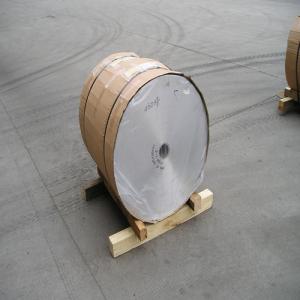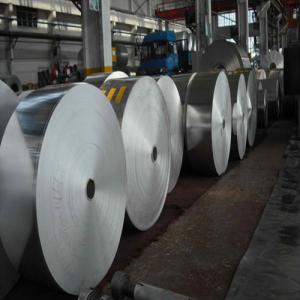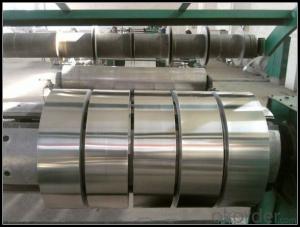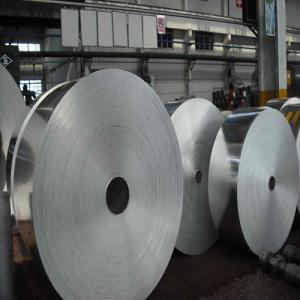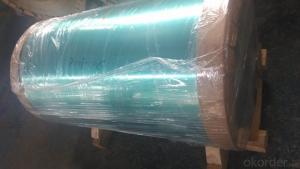Small Aluminum Strips AA1060
- Loading Port:
- China Main Port
- Payment Terms:
- TT or LC
- Min Order Qty:
- 5 Tons m.t.
- Supply Capability:
- 1000 Tons Per Month m.t./month
OKorder Service Pledge
OKorder Financial Service
You Might Also Like
1. Specifications of Aluminum Strips AA1060
Alloy Number | AA1060 |
Temper | Temper H12, H14, H16, H18, H22, H24, H26, H32,HO, F |
Thickness | 0.10-500mm |
Diameter | 10mm- 2200mm |
Standard | GB/T3880-2006, ASTM, ISO, EU standard |
Special specification is available on customers' requirements.



2. Usage/Applications of Aluminum Strips AA1060
Aluminum strips are widely used for PS printed materials substrate, building decoration materials, stamping products, building mirror materials, nameplate, insulation materials, aluminum plastic composite material, capacitor strip, transformer strip, welding parts, heat exchanger, clock surface and disk, kitchen utensils, reflecting apparatus etc.
3. Packaging & Delivery of Aluminum Strips AA1060
Packaging: Seaworthy package, bubble plastic bag inside, anti-moisture paper wrapped outside, covered with cartons, on wooden pallets, in containers. Pallet weight: Max. 2.30 tons.
Shipment: the goods will be delivered in 30 days after getting the buyer's payment.



4. Production Flow of Aluminum Strips AA1060
Rolling--Annealing--Slitting—Sawing, Cut-To-Length, Shearing
- Q: Why is the president of aluminum strip mildew, will affect the performance of the transformer?
- Can test the resistance, running temperature and other indicators, and the provisions of the comparison.
- Q: What are the potential dangers or issues that could arise from using nails or screws to attach aluminum strips?
- <p>There are several risks involved with using nails or screws to install aluminum strips. These include damaging the aluminum strip by causing dents or cracks, especially if the material is thin. There's also the risk of stripping the screw hole, which can weaken the hold and cause the strip to come loose. Additionally, if the aluminum strip is not properly secured, it may lead to accidents or injuries due to falling or improper installation. Using the wrong type of fastener can also lead to corrosion or other material compatibility issues. It's crucial to use the appropriate tools and techniques to minimize these risks.</p>
- Q: Is it possible to utilize aluminum strips in the construction of bicycle frames?
- <p>Yes, aluminum strips can be used for bicycle frames. Aluminum is a popular material for bicycle frames due to its lightweight, high strength, and good corrosion resistance. It offers a good balance between weight and durability, making it suitable for various types of bicycles, including road, mountain, and hybrid bikes. Aluminum frames are also known for their ability to absorb road vibrations, providing a smoother ride.</p>
- Q: Is it possible to use aluminum strips as a material for fencing?
- <p>Yes, you can use aluminum strips for fencing. Aluminum is a popular choice due to its durability, resistance to corrosion, and low maintenance requirements. It is lightweight, easy to install, and can be shaped into various designs. Aluminum fencing is also known for its strength and can be an effective barrier for security purposes. However, it may not be suitable for all environments, especially where high wind loads or heavy impacts are expected, as it can dent or bend more easily than some other materials.</p>
- Q: Is it possible to substitute metal sheets for asphalt shingles on a roof?
- <p>Yes, you can use metal sheets to replace asphalt shingles on your roof. Metal roofing is a durable and weather-resistant alternative to asphalt shingles. It offers benefits such as longevity, energy efficiency, and low maintenance. However, it's essential to consider the weight of metal sheets compared to shingles, as it may require structural reinforcement. Additionally, proper installation by a professional is crucial to ensure the roof's integrity and to maximize the benefits of metal roofing.</p>
- Q: Which brand of aluminium band for dry transformer?
- The domestic brand is 1060, and the state is soft. Suitable for winding.
- Q: What's the difference between aluminum strip and aluminum alloy?
- Aluminum strip is an aluminum processing product. It is produced by pressure processing (rolling) of aluminum alloy. Aluminum alloy is a broad term, generally referred to as aluminum alloy.
- Q: What are the properties, uses and classifications of aluminium strip?
- Aluminum strip is a strip of aluminum ingot obtained by press rolling, according to the use of different grades, specifications, status. The aluminum belt has many uses, such as: aluminum plastic composite pipe, cable, fiber optic cable, transformer, heater, shutter and so on.
- Q: This question asks for the distinction between two types of aluminum products: strips and profiles.
- <p>Aluminum strips are flat, thin pieces of aluminum, often used for applications requiring flexibility or where a thin cross-section is needed. They are typically used in packaging, electrical components, and construction. Aluminum profiles, on the other hand, are extruded shapes with a more complex cross-section, such as bars, tubes, angles, or channels. These profiles are used in structural applications, furniture, and various mechanical components where strength and specific shapes are required. The main difference lies in their form and application; strips are for flat, thin uses, while profiles are for more robust, structural uses.</p>
- Q: What types of aluminum strips are best suited for solar panel applications?
- <p>Yes, there are specific types of aluminum strips that are particularly suitable for use in solar panels. These include high-purity aluminum strips with low iron content, which are known for their excellent electrical conductivity and corrosion resistance. They are often used as busbars in solar cells to collect and transmit the generated electrical current. Additionally, aluminum strips with a high-strength alloy composition are used for structural support and frame components in solar panels due to their lightweight and durability. These aluminum strips are engineered to withstand harsh environmental conditions and maintain their integrity over the long lifespan of the solar panel.</p>
1. Manufacturer Overview
| Location | Henan, China |
| Year Established | 1996 |
| Annual Output Value | Above US$200 Million |
| Main Markets | Mid East;Eastern Europe;North America |
| Company Certifications | ISO 9001:2000;ISO 14001:2004;OHSAS 18001 |
2. Manufacturer Certificates
| a) Certification Name | |
| Range | |
| Reference | |
| Validity Period |
3. Manufacturer Capability
| a) Trade Capacity | |
| Nearest Port | Shanghai |
| Export Percentage | 30%-50% |
| No.of Employees in Trade Department | 21-50 People |
| Language Spoken: | English;Chinese |
| b) Factory Information | |
| Factory Size: | Above 100,000 square meters |
| No. of Production Lines | Above 10 |
| Contract Manufacturing | OEM Service Offered;Design Service Offered |
| Product Price Range | Average |
Send your message to us
Small Aluminum Strips AA1060
- Loading Port:
- China Main Port
- Payment Terms:
- TT or LC
- Min Order Qty:
- 5 Tons m.t.
- Supply Capability:
- 1000 Tons Per Month m.t./month
OKorder Service Pledge
OKorder Financial Service
Similar products
Hot products
Hot Searches
Related keywords
